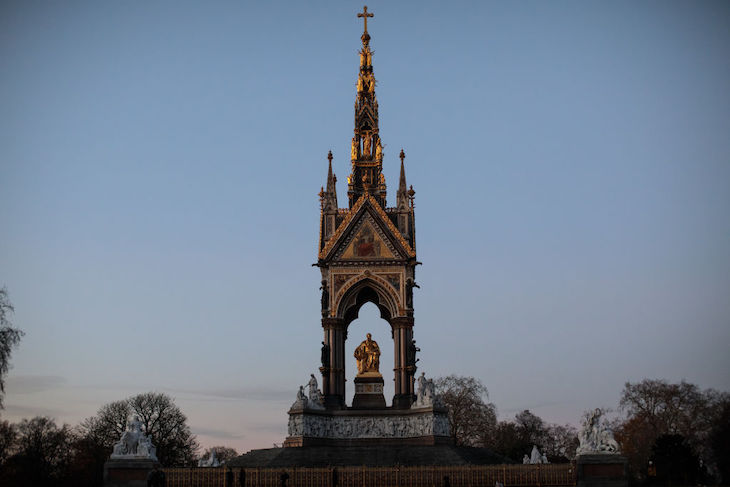The Prince Albert Memorial is the latest target of activists seeking to denigrate our past. The Memorial has stood in London’s Kensington Gardens for over 150 years as a moving tribute to Queen Victoria’s love for her husband. But now it has been branded ‘offensive’. Apparently, the sculptures at its base draw on ‘racial stereotypes’. Visitors were warned in a post – which has since been taken down – on the Royal Parks’ website that the memorial represents a ‘Victorian view of European supremacy’ which many today consider ‘problematic’. Really?
Royal Parks have chosen to hunt for remnants of Empire in order to condemn them
Culture Secretary Lisa Nandy announced on her first days in office that the ‘era of culture wars is over’. Yet the divisive and politicised critique of our national history continues, led by a minority of activists with little regard for the views of the public. If Nandy really wishes to end the era of polarisation, she should step in to stop the long march of ideology through the institutions.
The Albert Memorial, like many of London’s historic monuments, is managed by the Royal Parks charity. They are tasked with conserving London’s eight Royal Parks, which remain the inheritance of the Crown, a job for which they are given around £10 million by the government. Royal Parks, which was formerly an agency of the Department for Digital, Culture, Media and Sport (DCMS), was reconstituted as a charity in 2017. In a curious arrangement, they act as a public corporation of DCMS with oversight and management of their appointments from the Culture Secretary. The Royal Parks Charity is expected to manage, protect and improve the parks in an exemplary and sustainable manner so that everyone, now and in the future, has the opportunity to enjoy their natural and historic environments. Yet it seems that, in this case, they have used the freedom their charitable status affords them to pursue a radical and contested approach to history.
In describing the Albert Memorial as an example of ‘British supremacy’, Royal Parks have chosen to hunt for remnants of Empire in order to condemn them, rather than focusing on their role as protectors of the parks of which they are stewards.
Since the summer protests of 2020, the custodians of British heritage have been repeatedly pressured to bend to the will of a small group of campaigners with no regard for the views of the public.
Responding to this corrosive pressure, last year the government published their ‘retain and explain’ guidance, informed by Policy Exchange’s paper, History Matters: Principles for Change, for custodians facing calls to remove, or otherwise denigrate, heritage assets.
The carefully developed ‘Retain and Explain’ government guidance sets clear standards for custodians who feel the need to remove or otherwise ‘explain’ the presence of a statue. Those wishing to make public comment on a statue are expected to present ‘a full and rigorous review of the historical evidence available’, including ‘peer assessment of the evidence and conclusions’. Did Royal Parks undertake any historical analysis before damning Albert? There certainly appears to be no reference to ‘peer assessment’ on the offending article about the memorial. Indeed, the comments on their website are given no specific attribution.
Rather than consider the Memorial as a product of the time which created it, they are condemning it precisely because it reflects a ‘Victorian view of the world that differs from mainstream views held today’. But why won’t Royal Parks laud the depiction of broken chains on the Memorial, an allusion to Albert’s role in abolishing slavery across the world?
What this story shows is that it is not enough for ministers to simply publish non-legally binding advice. Nandy should take direct action to hold Royal Parks accountable for their refusal to adhere to the government’s published instructions for managing contested artefacts.
If Royal Parks continue to disparage the historical assets in their care, then action must be taken. A new chair of the charity, Dame Mary Archer, takes office today. Nandy should make clear to Archer that the divisive and politicised curation of monuments will not be tolerated.
Even Royal Parks seem to recognise their mistake. The page on the website discussing ‘Albert in the Age of Empire’ has been removed, replaced by a link which states ‘you are not authorised to access this page’. A Royal Parks’ spokesperson told the BBC: ‘In light of recent feedback, we will review the online information we have provided to tell the story of the Albert Memorial.’
Nandy is not powerless. She can hold Royal Parks accountable. If the trustees of the charity refuse to preserve that which they’re tasked with protecting, then they can no longer be allowed to maintain such a precious piece of our national inheritance.
When activists seize control of history, the Culture Secretary represents our last line of defence. It is government inaction that has allowed our nation’s heritage assets to become so vulnerable to repeated denigration.








Comments